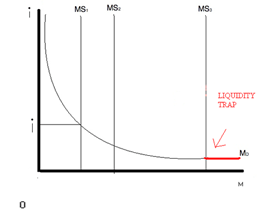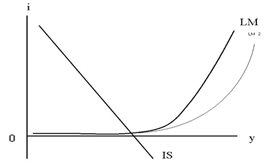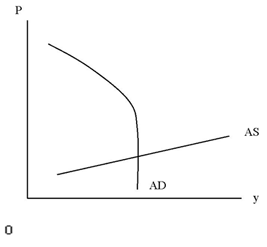Describe what is meant by the liquidity trap. Discuss the problems posed by the liquidity trap and the optimal ways to escape from it.
Definition of a Liquidity Trap
John Maynard Keynes introduced the concept of a liquidity trap. During the Great Depression in the 1930’s in the US, Keynes found that the economic stimulators did not have the necessary effects. A liquidity trap is a situation characterised by low or zero interest rates which fail to stimulate consumer spending and investment, thus “people are willing to hold unlimited real money balances at the given interest rate” Levacic and Alexander (1982: 92).
One of the most crucial aspects of Keynes’s theory is expectations, as they play a huge role in determining speculative balances. People will form expectations of interest rates by making comparisons between the existing interest rate relative to the norm.
Problems
There will be an unwillingness to hold bonds if interest rates are low – “everyone expects that interest rates will soon rise and bond prices will fall inflicting huge capital losses on anyone foolish enough to hold bonds or interest bearing assets” Gailbraith and Darity (1994: 151).
In the UK there was an increase in precautionary savings and a fall in spending when “interest rates were cut to 0.5% in 2009” Pettinger (2009). This resembled a liquidity trap as the Bank of England conducted quantitative easing by buying bonds as the economy was in a recession. But was it really a liquidity trap as prices were rising, or did the quantitative easing increase inflation?
The zero lower bound for interest rates implies that the nominal interest rate cannot fall below zero or cash would be preferred to bonds and lenders would never lend at a negative interest rate and so it becomes difficult for consumers to borrow.
If there is deflation or deflation expectations even if nominal interest rates are zero, real interest rates can be positive and maybe too high to stimulate the economy effectively.
The Fisher Equation, which states that the real interest rate is equal to the nominal interest rate minus expected inflation, will need to be low to stimulate consumption and investment and thus aggregate demand. But if nominal interest rates are low and accompanied by low inflation then there is not much the authorities can do to stimulate the economy using interest rates and thus monetary policy is ineffective.

Figure 1 shows the liquidity preference, Keynes argued that a fall in nominal interest rates increases the demand for money, but this does not occur in a liquidity trap as MD becomes flat.

Figure 2 shows that when the interest rate is near zero the demand for money becomes more or less infinitely interest elastic, shown by the horizontal LM curve. If the IS curve intersects the LM curve, as shown in figure 2, the aggregate demand for goods will be less than the potential full employment and investment is zero because the interest rate is zero. Increases in the money supply will stretch the LM curve to the right with no effect on interest rates and output. This means people will become indifferent in holding money and bonds; there is no opportunity cost of holding money so open market operations have little effect on prices.

When prices fall in a liquidity trap people may hold more money because they are expecting prices to be even cheaper tomorrow, so no one invests or consumes and hence there is no effect on aggregate demand. Shown in figure 3 where AD is kinked.
Pigou disagreed with this and argued that a fall in the price level increases the public’s holding of money and that this wealth effect increases consumption and the IS would shift to the right, closing the gap between aggregate demand and aggregate supply.
Japan in the 1990s is a prime example of the effects of a liquidity trap where there was stagnation and deflation. The Bank of Japan lowered interest rates to zero and conducted quantitative easing to expand the monetary base, but this did not stimulate the economy. Japan couldn’t increase demand in the economy even though prices fell, as people didn’t automatically start buying. Japan committed to keep interest rates low to stop expectations but people still did not react (kinked AD curve).
Optimal Ways to escape
An optimal way to escape a liquidity trap is if the central bank could alter the private sectors’ belief about future inflation as then a lower real interest rate would provide the required stimulus to the economy. However, this is complex to do. A credible policy could push the economy to a high level of output and a high level of inflation.
The central bank could announce a positive inflation target as a commitment to higher future inflation; this would be credible if they set the target higher than normal. But there would need to be promise of commitment e.g. inflation forecasts and reports.
An announcement of an upward sloping target for the price level by the central bank would be advantageous because in the long run even if inflation is low in one year there would be higher inflation in the following years to make up for this, whereas this is not the case for an inflation target. Thus the price level target is likely to be more credible and successful in fulfilling inflation expectations.
The only way an increase in the money supply could end a liquidity trap is if it was permanent and so credible, then it could reduce real interest rates through expectations of higher inflation. Or, depending on the response of the private sector fiscal policy may provide the required stimulus through IS movements. If, for example, the private sector feels that the budget deficit is high, any expansionary fiscal policy will be offset by increased private sector savings, through fear of future tax increases; expansionary fiscal policy financed by bonds in Japan was ineffective.
The central bank could reduce long term interest rates even if short term interest rates are zero, which would reduce the long term real rates and stimulate the economy. This could be done if the government agreed to buy all bonds after placing a low interest rate ceiling on them.
Another potential escape is by placing a tax on money, as this would imply negative nominal interest rates that could stimulate the economy, and thus remove the zero bound on nominal interest rates.
Currency depreciation could stimulate the economy through the effects on export and import competing sectors. The long term inflation expectations needed by the private sector can be created by an exchange rate peg that will persuade the private sector of a higher future price level. A higher future price level entails a higher future exchange rate, but for this to happen the current exchange rate needs to depreciate by an equivalent amount of the future expectations of a higher price level. Looking at whether the current exchange rate depreciates will show whether or not the policies implemented to achieve a higher future price level have been successful or not. The policies in Japan can’t have been effective in increasing future price level expectations as there was no significant depreciation of the currency. Currency deprecation was effective in the US in 1933 as it contributed to ending deflation.
Svensson (2003:161) said that McCallum (2000, 2002, 2003) has proposed a “moving exchange rate target rather than an exchange rate peg as a way to escape from a liquidity trap”. He claimed the exchange rate would depreciate if inflation was below its target or if there was a negative output gap.
Svensson (2003: 161) argues “the best way to escape a liquidity trap is the foolproof way which consists of 1) an upward sloping price level target path; 2) a depreciation and a crawling peg of the currency; and 3) an exit strategy in the form of the abandonment of the peg in favour of inflation or price-level targeting when the price-level target path has been reached”. So Svensson’s foolproof way incorporates all the optimal ways discussed above and is applicable to any open economy.
Concluding Remarks
The idea of a liquidity trap where a central bank could not reflate the economy seems rare, extreme, and according to Monetarists, unrealistic. Numerous assumptions need to be made; e.g. does a fall in real interest rates raise output and do falling prices mean people hoard money? Japan in the 1990s and the Great Depression in the 1930s are the only major examples of a liquidity trap but Anon (2011:83) suggests “deflation in Japan is not so much a monetary problem as a structural one”, so it could be demographic problems contributing to the persistent deflation in Japan and “what really matters to business’s are future profit margins” Jackson (2005), which could be a reason why low interest rates did not stimulate the economy.
On the other hand, if there is uncertainty or crisis in the economy, people will hold money as a store of value as they will perceive it to be safer than interest bearing assets, so the Keynesian view that spending was good and saving was bad may not be so farfetched.
Because of the liquidity trap changes in the money supply do not effect employment and GDP, which are real variables. But this does not mean money is neutral as postulated by the Classical Economists, because when the economy is not in a liquidity trap money supply changes affect real variables.
With traditional monetary policy being ineffective, unorthodox methods to stimulate the economy may be more successful. Of the optimal methods explained currency depreciation seems the most optimal, but however, it may be even more optimal to combine methods, just like Svensson’s foolproof way, to increase the chances of ending the trap.
Bibliography
Anon, (2011). An Old Problem.
The Economist 12 February.
Gailbraith and Darity, (1994) Macroeconomics.
USA: Houghton Mifflin.
Jackson (2005) Japanese economy and the liquidity trap: another Keynesian fallacy.
Available at: < http://www.brookesnews.com/052103japan.html >
[Accessed 26 February 2011]
Levacic and Alexander, (1982) Macroeconomics an introduction to Keynesian-Neoclassical controversies.
London: Palgrave Macmillan.
Lewis and Mizen (2000) Monetary Economics
Oxford: Oxford University Press
Pettinger (2009) Liquidity trap explained.
Available at: <http://econ.economicshelp.org/2009/10/liquidity-trap-explained.html>
[Accessed 20 February]
Svensson Lars (2003) “Escaping from a Liquidity Trap and Deflation: The Foolproof Way and Others”, Journal of Economic Perspectives, Volume 17, No 4,145–166.